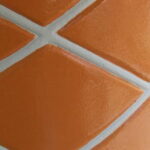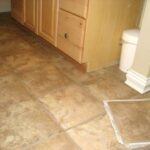Marble flooring is quickly becoming one of the most popular flooring choices among those doing home improvement projects. Marble is a naturally occurring stone product that comes in a variety of natural tones. The tiles are durable and look very classy when installed properly. In the past ten years, marble and other stone product sales have grown at a rate of 2,000 percent. Beautiful, durable, and relatively easy to install, marble flooring is a great choice for the do-it-yourself home improvement project. As with any home improvement product, before deciding on a marble floor make sure you understand the pros and cons of your flooring choice.
Choices for Marble Flooring
There are two standard choices for your marble flooring, and each will create a different effect in your home. Traditional marble tiles have a polished, shiny finished, which adds a touch of class to a room. These tiles look great in an entryway or foyer. A newly popular variety of marble flooring is tumbled marbles. These marbles come in beige and milky tones. Instead of being polished, they are buffed, and the finish is earthy and natural looking. These tiles work well in large areas, such as kitchen/dining room combinations, as they often come in larger sizes.
What You Need to Know About Marble Flooring
Before beginning to install, you need to know a few things about marble flooring. First, certain substances, such a shampoo, nail polish remover, and other common household products can cause permanent staining to marble. To avoid this, the tile should be sealed using a neutral pH breathable sealer after installation. The sealer will need to be reapplied periodically, but will protect your floor from permanent staining. Depending on the amount of foot traffic the floor will receive, the flooring should be resealed every 9-18 months. Second, marble floors should not be cleaned using commercial floor cleaners. Clean your marble floor with just warm water. Tough stains can be removed using a peroxide soaked paper towel. Place the towel over the stain and cover it with plastic wrap. Leave it long enough for the peroxide to dissolve the stain, and then wash with warm water. After cleaning your floor with warm water, follow with a dry paper towel, because water can damage marble flooring. Because light colored marble can stain so easily, you may want to consider using a darker variety, especially if your floor is in a high-traffic area.
One benefit of marble flooring is its natural cooling properties. Marble is an extremely dense solid and does not conduct heat well; because of this it takes a long time to heat up. This property makes marble particularly popular in warm climates. You may want to consider some area rugs if you are prone to cold feet in the morning!
How to Begin Installation
Installing marble flooring is done in the same way as installing ceramic tile. The main difference is the marble has greater weight than the ceramic tiles. First, start with a completely clear floor. Test the floorboards to make sure they are sturdy. If they are not sturdy, the grout between the tiles could crack. If the floor needs to be stabilized, add joists or jack supports to the level below the floor. After checking for stability, you need to check to be sure your floor is level. Using a long level, check for slope in the floor. Also check under the level to look for dips in the floor. If necessary, build up the floor. A level floor is a must for installing a marble floor.
A cement backer board can be screwed directly to the plywood. This will reinforce the floor, since marble tiles are relatively heavy. The tiles do not give and are prone to cracking if the floor is not sturdy and unyielding. If you choose not to use a cement baker board, you will need to reinforce your floorboards with another layer of plywood. The tiles will be applied using a thin-set adhesive.
Once you have prepared your floor, it is time to start installing your marble. Start by finding the center of the room. Measure both the length and the width, and put a chalk line down the center of each. Where these lines intersect is the center of the room. Now, the next step is very important. Lay out your marble in a test run. This is important because if you end up with a tiny piece of marble at any end, you will need to shift your center line a little to avoid having a tiny edge on one end of your floor. To keep a symmetrical look, have the starting tile straddle the centerline if needed.
Now you are ready to begin laying your marble flooring. Start with a tile near the center. Trace around the outside of this tile. Apply mortar, preferably a thin-set mortar, inside the lines you traced. Place your tile on the mortar. This is your reference point for the rest of your floor. From this tile, spread your mortar and use a trowel to notch it. When applying mortar over seams in the floorboards, apply mesh mortar tape to the seams. This prevents cracks in the grout when you are finished. After putting each tile on the mortar, place a 1/16-inch spacer between it and the next tile. This will ensure that the finished project has and evenly spaced appearance.
Once you have finished laying your tile and given the mortar time to dry, it is time to seal the marble. Sealing is best done by a professional and is very important since marble is so easy to stain. Remember to have the sealing reapplied every nine to eighteen months.
Benefits of Marble Flooring
One benefit of any type of tile flooring, including marble, is that if it is damaged or stained, you only need to replace the damaged tiles, not the entire floor. With a carpet or hardwood floor, significant damage would require replacing the flooring for the entire room. You may want to consider buying some spare tiles, in case you need to replace some in the future. Styles change, and you may not be able to find an exact match to your flooring after a few years.
Now that you have your stunning marble flooring, ensure its longevity by a few simple things. First, whenever possible, remove your shoes before walking on the marble. Shoes pick up oil and dirt, and these substances can scratch and stain your floor. Along the same lines, make sure your sweep or vacuum your floor before popping, that way you will not grind any dirt particles into your floor.
Marble flooring will add class to any room of your house. Keep in mind that marble requires special cleaning and proper installation. If you care for your floor properly and remember to have it sealed periodically, you can enjoy the elegant look of marble for years to come!






